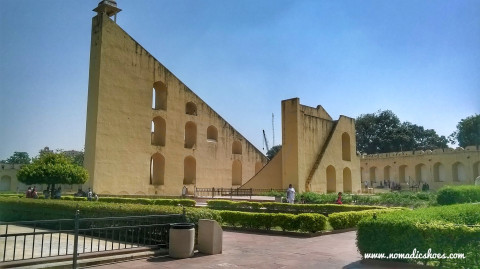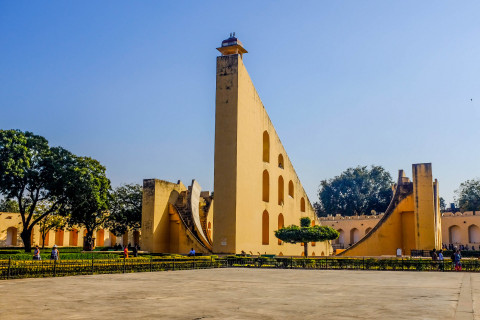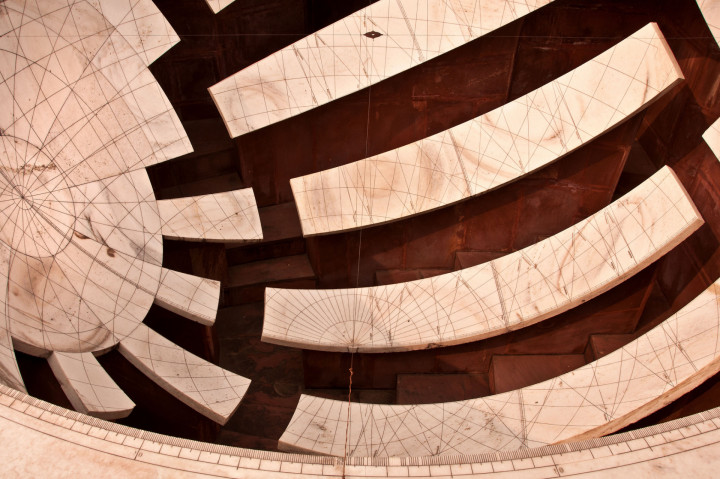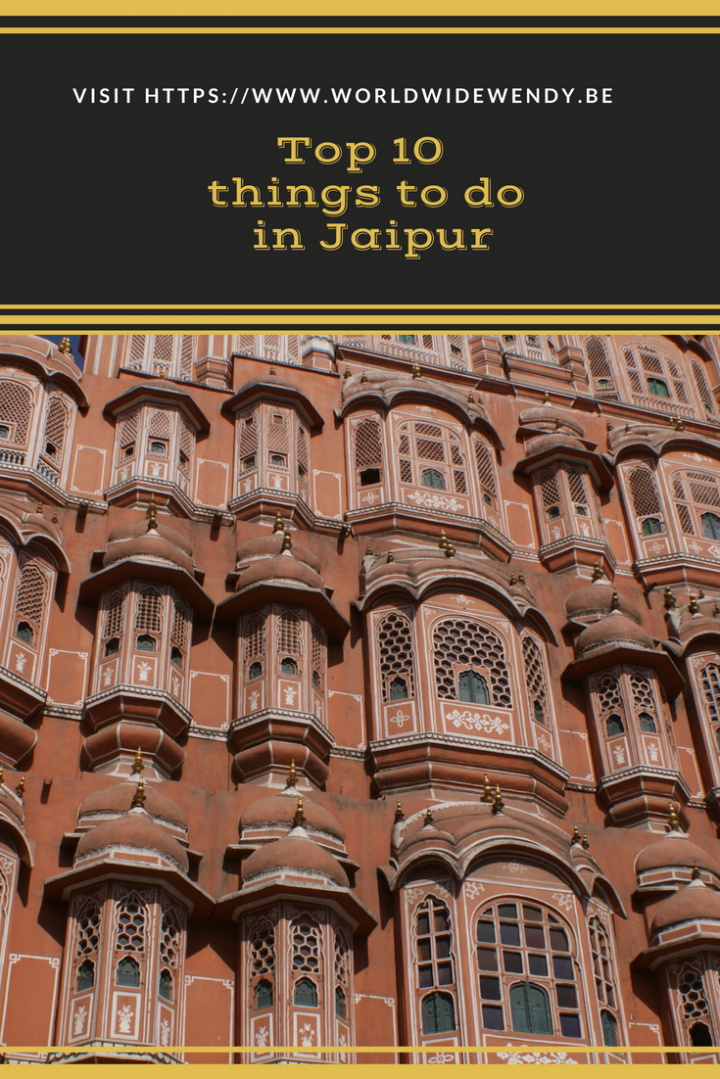Jaipur is the capital city of Rajasthan. Maharaja Jai Singh II founded the city of Amber in 1727, but when it got too small, the current capital of Jaipur was founded. Halfway through the 19th century, the city was bursting at the seams again, and new areas were built outside of the city walls. The city gets his nickname “Pink City” from the many pink-coloured buildings. In 1876, the city was painted this colour in honour of the visit of the Prince of Wales, as pink is the colour of hospitality.
Amber Fort
The most impressive attraction is the fort-palace of Amber, also known as Ajmer Fort. The city was founded as the capital of the empire . After the court moved to the current Jaipur, the kings would still visit Amber Fort to ask for the blessing of the god Shila Devi.
The Citadel (a building in a fortress, it was meant to keep the commoners under control or to provide the city with protection against attacks) was built at the end of the 16th century on the ruins of an 11th-century fort.
Jai Singh I added a few impressive buildings in the 17th century. In total, it has four large parts, each with its own courtyard.
We admire our surroundings on the way to Amber Fort. We enjoy the beautiful landscapes and architecture but then we are also regularly confronted with the poverty in India. Elephants in traffic are, unfortunately, also still an everyday occurrence.





The first glimpse of the fort is a magnificent one. The fort rises high above us on top of a hill. The kilometres-long walls make you realise how large the original city was.


After quite a steep drive up (about 400 rupees if you don’t have a guide with a car. Of course, you can walk all the way too), and a last climb on foot, you enter the palace.
The courtyards are all breath-taking, and you get great views of the city everywhere. Especially Jai Mandir with its lovely garden is spectacular.
The Ganesh Pol is the most beautiful in my opinion. It is decorated with beautiful tiles and has three floors. Through this gate you will reach the private quarters meant only for the women. Every woman had her own small room. A corridor allowed the Maharaja to visit any room without the other women knowing where he went. Jealousy is nothing new apparently.


Sheesh Mahal (Glass Palace) is a domed room. When candles are lit, the shards of glass in the ceiling give the impression of a twinkling, starry night.

Jas Mandir was the room for private audiences. The alabaster ceiling here is also insanely beautiful.



One of the rooms gives you a beautiful view of the former saffron garden.
Amber Fort is so beautiful that it has been the location for many Bollywood films.

Jaigarh Fort
Jaigarh or Fort of Victory, is about 15 kilometres outside of Jaipur and protects the old capital of Amber. It was built at the start of the 18th century by Sawai Jai Singh II as a military fort and treasury.
In a secret, underground chamber a gigantic treasure is supposedly buried. The rumours were so strong that the Indian government closed the fort to the public in 1976. A fruitless search ensued, and the fort was reopened seven years later.


The 50-tonne Jai Van (or Jaiban) cannon dating to 1726 sits atop the roof. This is probably the largest cannon on wheels in the world. The cannon’s barrel is 7 meters long and the wheels are almost 1.5 in diameter. One shot needs 100kg gunpowder. The ball will shoot 35km away. Apparently, it was never shot again after the first trial shot was fired.
You have a wonderful view of the surrounding area, Fort Amber and Jal Mahal or Lake Palace. The courtyard garden is also definitely worth a visit.

You want to read everything about our trip to India? Wil je het volledige verslag van onze reis naar India lezen? Read 'Rajasthan in India: 1 week itinerary'.
Jal Mahal or Lake Palace
One of the most Instagram worthy places is Jal Mahal. This sandcoloured palace is situated between Jaipur and Amber Fort in the middel of a deep blue lake, Man Sagar. It seems like the palace is floating You can't visit the inside of the palace, but sit down besides the lake and enjoy this magnificant view.


Taste of Jaipur
India is not known for its hygiene, so tasting street food is a risky business. There are some trusted places however.
Lassi
Lassi is a traditional yoghurt drink that they sell on every street corner. The Indians love it. Lassiwala (315 M I Road) creates this treat since 1944 and is a trusted address to try this drink. They pour the Lassi in a clay mug that you can take home. It makes an original souvenir.

Tea
Indians also love tea. Go by one of the many teahouses and enjoy their delicious tea. As the water is boiled there is only a small risk (but don’t shoot me if you do get sick).

Bombay Mix
The same way we enjoy crisps or nuts, they like to enjoy their Bombay mix in India. Look for a stall that looks nice and tidy (or check with your hotel to get a recommendation) and taste a few varieties. But be warned: Spicy!

Historic centre
A visit to the heart of the city is a must. Enter the city through the beautiful Ajmeri Gate. Wander through the maze of little roads and witness daily life in India. Or even better: explore the city by bike. We did a super-cool bicycle tour of Jaipur. Read all about it in 'Cycling in Jaipur'.


Govind Devtempel
This special temple is dedicated to Govind Dev Ji or the flute-playing Krishna. On a stage, behind a curtain stands a statue of this god. Originally, the statue was in Brindavan. It was brought to Amber at the end of the 17th century to keep it out of the hands of the Mughal emperor.
According to the legend, the temple was a garden pavilion of Sawai jai Singh II. One nght, Krishna spoke to him and demanded to have his devasthan or godly house returned to him. Jai Singh moved and placed the statue of Govind Dev Ji in the temple as protector god of the rulers of Jaipur.
We witnessed a service in this temple. Hundreds of Indians gathered in front of the podium and started a hypnotising song. The moment the curtain on the stage opened, all hands went into the air. After a few minutes the curtain is closed and the service is over. Strange but unique experience.

Be sure to have a look at the covered square beside the temple. The massive roof span made it into the Guiness Book of World Records.

Local markets
India is the land of a thousand scents and colours. You can really experience this at the local markets. We visited the Johari Bazar, an open-air market full of fruits and vegetables. It all looks delicious, but I didn’t taste anything.

The flower market is also worth a visit. Buy a garland of marigolds to offer in one of the temples.

Albert Hall Museum
.The foundation stone of this extraordinarily beautiful building was laid by the Prince of Wales in 1876. They didn’t know what function the building was going to have. A school, a cultural centre or government building – anything was still possible. Eventually it became a museum.
Inside you can view a 9-meter-long phad (roll of fabric) on which scenes from the life of Pabuji, a 14th -century folk hero, are painted. The museum also boasts one of the world’s largest collections of Persian garden tapestries.

Hawa Mahal of Palace of the Breez
This strange building is one of the highlights and symbols of Jaipur. It is in fact not a building, but a façade with long corridors behind it. Hawa Mahal was built for the women in the harem of the Maharaja of Rajasthan. It allowed them to view the annual parades and daily life without being seen themselves. From a distance, the building resembles the mukut or crown that Krishna often wears.

Jantar Mantar
Unfortunately, we did not have enough time to visit this landmark. Sawai Jai Singh II had 5 observatories built, and this is the best-preserved one. Jai Singh had a great interest in astrology and the 16 instruments that were built here between 1728 and 1734 look like sculptures. A number of these instruments are still used to measure the summer heat and the intensity of the monsoon. This way they predict the chances of flooding and hunger. Take a tour of the Jantar Mantar to learn all about this remarkable landmark.
The entire ste is on the Unesco Worldheritagelist.

Credits: Nomadic Shoes Follow Susan on Instagram.

Credits: Tripgourmets.

Credits: Second-Half travels. Follow Ingrid on Instagram.
Jaipur has a lot more to offer obviously, but you need 2 or 3 days to visit the best things to do in Jaipur.
Have you discovered something special to see in Jaipur? Share them in the comments below.
Pin this one for later!

